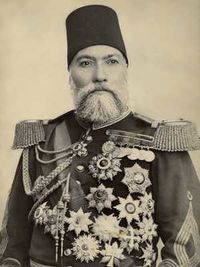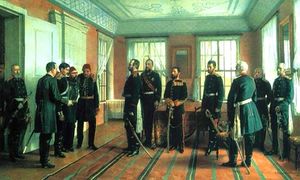عثمان نوري پاشا
عثمان نوري پاشا | |
|---|---|
 صورة عثمان نوري پاشا تصوير عبد الله إخوان، اسطنبول حوالي 1895. | |
| الكنية | 'غازي' |
| ولد | 1832 توقاد في وسط الأناضول |
| توفي | 5 أبريل 1900 (عن عمر 67 أو 68) اسطنبول |
| الولاء | الدولة العثمانية |
| الرتبة | مشير |
| المعارك/الحروب | حرب القرم الحرب الروسية التركية (1877–1878) * حصار پلڤنا ومعركة لوڤچة |
| الأوسمة | مارشال القصر نشيد عسكري عثماني بعنوان مختار مارشي أُلـِّف عن انجازاته |
عثمان نوري پاشا أيضاً غازي عثمان پاشا Gazi Osman Pasha (عاش 1832- 5 أبريل 1900) كان مشيراً في الجيش العثماني وبطل حصار پلڤنا في 1877. وقد حصل على لقب 'غازي' تقديراً لدوره في ذلك الحصار.
النشأة
وُلِد عثمان نوري پاشا في عائلة (ياغجياوغولاري) المرموقة في مدينة توقاد في وسط الأناضول. أبوه كان موظفاً حكومياً. بعد مولد عثمان بقليل، عـُيـِّن أبوه في منصب في العاصمة العثمانية، وانتقلت الأسرة إلى الأستانة (اسطنبول)، حيث درس عثمان. وقد تخرج من الكلية الحربية في 1852، والتحق بسلاح الفرسان في بداية حرب القرم، حيث أظهر تميزاً مما جعله يترقى الرتب سريعاً.
في 1861 تعامل عثمان بحنكة مع المتمردين الكريتيين ومشاكل اليمن في 1864. وقد عاد من اليمن حاملاً اللقب "پاشا". ثم عـُيـِّن قائداً عسكرياً على سنجق سكوتاري (شكودر) وولاية البوسنة. وبسبب نجاحه في اخماد التمرد البلغاري 1876، فقد رُقـِّي إلى رتبة "مشير".
الحرب العثمانية الروسية (1877–1878)
بعد اعلان الحرب الروسية التركية في (24 أبريل)، تحركت القوات الروسية، بقيادة شقيق القيصر نيقولاي جنوباً باتجاه الدانوب. The only well-manned Ottoman fortress opposing them was at Vidin, where Osman’s forces were garrisoned having just defeated the Serbs.
While Osman's forces were in Vidin, his erstwhile commander سليمان پاشا was on the Montenegro border, and عبد الكريم نادر پاشا, the other divisional commander, was in Greece. There were only 186,000 Ottoman troops in the Balkans, of which Osman had less than 20,000. عندما عبر الروس الدانوب وغزوا بلغاريا في Svishtov in July, the Ottoman high command sent Osman to reinforce the city of Nikopol. Before Osman could reach Nikopol, the Russian vanguard had taken the city in the Battle of Nikopol (16 July) and Osman settled on Plevna to the south. Plevna was a more strategic location being the center of transport and communication lines in northern Bulgaria. Osman started by ordering trenches dug around the city. These trenches are considered an early example of modern bastion defensive works. He literally took his artillery and men under the ground. While Osman was still constructing these fortifications, the Russian forces began to arrive (19 July). However, the Russians were used to warfare in open territory, and sent columns of infantry to directly attack the fortifications. Osman’s defence repelled two Russian attacks with huge casualties on the Russian side. Most analysts agree that a counter-attack at this point would have allowed the Ottoman forces to gain control and destroy the bridge at Svishtov. However, Osman had explicit orders to stay fortified in Plevna, and so did not take advantage of the opportunity.
The Russians continued to bring troops across the Danube, including a Romanian contingent; while Osman was only reinforced by the troops retreating from the معركة لوڤچة which had cut the Ottoman supply lines.
The death-toll was high in the trenches as well as among the Russians. The city of Plevna itself partially burned from artillery fire. Indeed, as time passed, starvation began in Plevna and munitions were running out. With no help coming from the outside, and Suleyman Pasha's attempts to open a breach for the Ottoman forces in the key Shipka Pass of the Balkan Mountains having failed several times, Osman finally decided in October to end the siege and retreat. Osman requested permission to abandon Plevna, but the Ottoman high command refused him (24 October). After another month, with supplies exhausted, Osman finally made an attempt to breakout from the Russian siege, together with the civilian Turkish population of the city (9 December). The siege had lasted 145 days (about five months).
Osman managed to cross the Vit River, and attacking along a 2-mile front broke through the first line of the Russian trenches. However, the Russians turned their artillery and the Ottomans were driven back. Osman himself was wounded in the left leg by a splinter of an artillery shell and was taken to a mill where his injury was bandaged. The next day two Romanian officers came to the mill and requested his "unconditional surrender". Osman surrendered his sword to the Romanian colonel Mihail Cerchez, who nevertheless refused to accept it waiting for orders from the commander of the Romanian expeditionary corp - the Romanian prince Carol I. Osman and his aide-de-camp Talat Bey were being taken back to Plevna city in a cart when they came across Russian commander, Grand Duke Nicholas, on the way. Grand Duke Nicholas said to Osman Pasha: "I congratulate you for your success in defending Plevna. This defense is one of the brightest military occurrences in defensive history." The next day when Osman was taken before Czar Alexander II he was asked why he had not surrendered sooner. Osman replied: "My state gave those weapons to me for fighting, not to drop them at the sight of the enemy. They sent me here to fight." The Czar returned Osman’s sword as a mark of esteem.[1][2]
Fifteen days later, the Russians took Osman to Harkov where he remained in captivity for the duration of the war. Upon Osman’s return to Constantinople, he was acclaimed by large crowds. Soon afterwards, Sultan Abdul Hamid II appointed him as Marshal of the Palace. Osman wrote a book about the Siege of Plevna entitled Défense de Plevna, d'après les documents réunis par Mouzaffer Pasha et Taalet Bey (Paris, 1889).
الأعقاب
Over the next 20 years Osman Pasha served the Ottoman Empire four times as the Minister of War. He died on 5 April 1900 at the age of 67. He was buried in the garden of the Fatih Mosque as he had requested. An Ottoman military march called Plevna March was composed for his achievements during the Russo-Turkish War.
Gaziosmanpaşa (GOP), a district in Istanbul is named after Osman Pasha.
ملاحظات
مراجع
- Parry Melanie (ed.) (1997) "Osman Nuri Pasha" Chambers Biographical Dictionary (6th ed.) Larousse Kingfisher Chambers, New York, ISBN 0-550-16060-4 ;
- Dupuy, Trevor N.; Johnson, Curt; and Bongard, David L. (1992) "Osman Nuri Pasha" The Harper Encyclopedia of Military Biography HarperCollins Publishers, New York, ISBN 0-06-270015-4 ;
- Hülagü, M. Metin (1993) Gazi Osman Paşa, 1833–1900: askeri ve siyasi hayatı Boğaziçi Yayınları, Istanbul, ISBN 975-451-094-6 ;
- Yenice, İhsan and Fidan, Raşit (2001) Plevne kahramanı Gazi Osman Paşa, 1833–1900 Gaziosmanpaşa Belediyesi Kültür Yayınları, İstanbul, ISBN none;
- Uçar, Nail (1978) Gazi Osman Paşa ve Plevne Orkun Yayınevi, Istanbul, ISBN none;
- Herbert, Frederick William von (1895) The Defence of Plevna: 1877. Written by One who took part in it Longmans, Green, and Co., London; reprinted 1990 by Ministry of Culture, Ankara, ISBN 975-17-0604-1 ;
روابط خارجية
- Infobox military person image param needs updating
- Pages using infobox military person with unknown parameters
- Persondata templates without short description parameter
- مواليد 1832
- وفيات 1900
- أشخاص من توقاد
- Ottoman military personnel
- أسرى حرب أتراك
- أسرى عثمانيون
- پاشوات
- جنرالات مسلمون
- موظفون عموميون عثمانيون
- مشيرو الدولة العثمانية
- People of the Russo-Turkish War (1877–1878)

